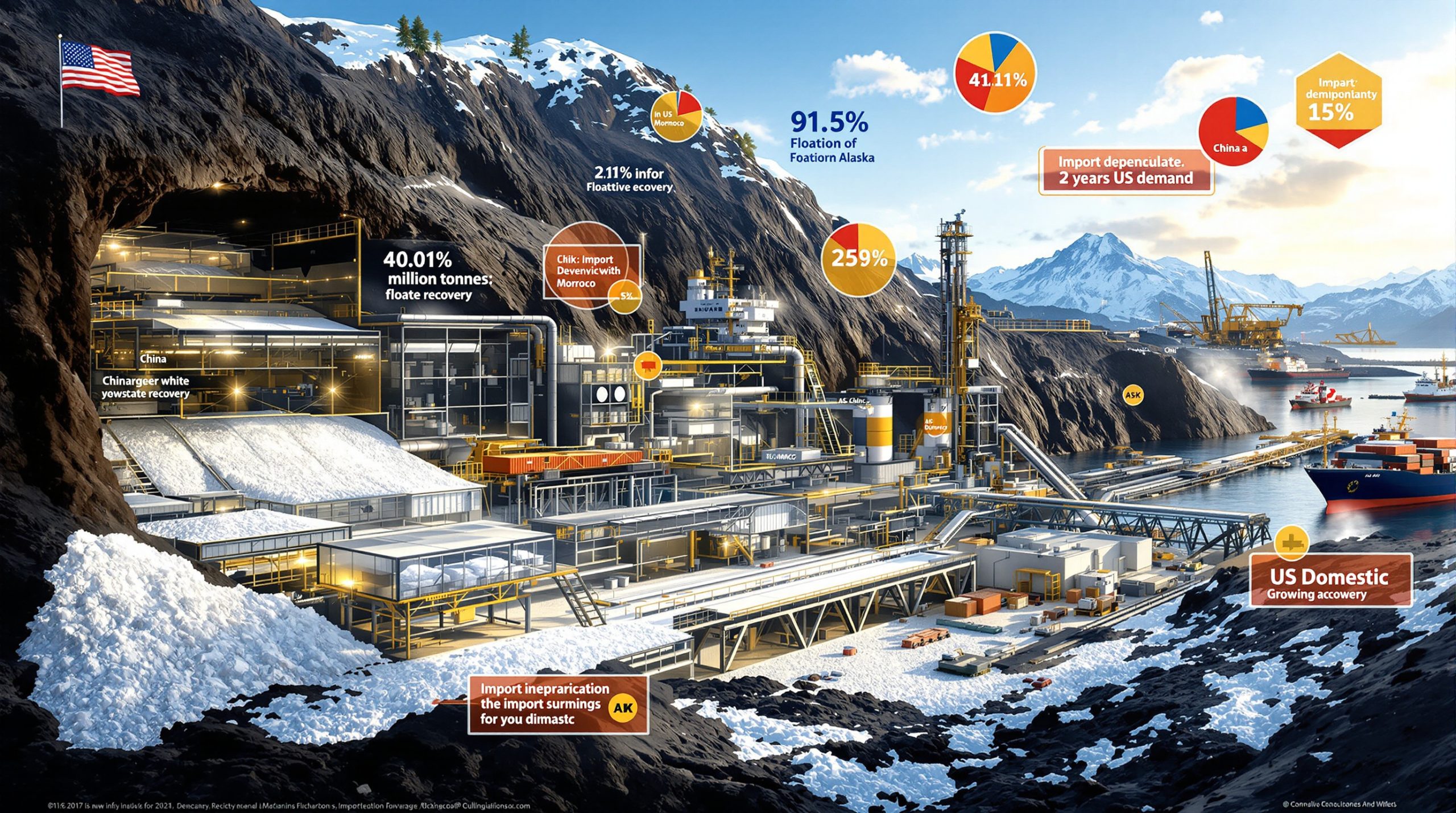The recent partnership between US miner to revive Mali's Morila gold mine represents a significant development in West African precious metals extraction, particularly as gold prices analysis reaches unprecedented levels. This collaboration between Flagship Gold Corp and Mali's state-owned mining entity SOREM marks the first American investment under the country's controversial 2023 mining code.
Strategic Location and Historical Significance
Mali's position as one of Africa's leading gold producers has made it a focal point for international mining investment. The country's gold production reached approximately 65 tonnes in 2023, establishing it as the continent's third-largest producer behind Ghana and South Africa.
The Morila mine sits within the mineral-rich Sikasso region, an area that has attracted major mining companies for decades. This strategic location places the operation within Mali's established gold corridor, where infrastructure and geological understanding support efficient extraction activities.
West African gold mining operations have historically drawn global investment due to the region's favourable geology and established mining frameworks. Furthermore, the Sikasso region has demonstrated consistent mineralisation patterns that support long-term extraction projects.
Economic Impact on Mali's Mining Sector
Mali's economy depends heavily on gold mining, with the sector generating approximately 70-75% of total export revenues as of 2023. This heavy reliance on precious metals exports makes mining project revivals critical for national economic stability.
The potential reopening of Morila comes at a crucial time for Mali's mining sector. Industrial gold production plummeted 32% year-on-year to 26.2 tons through August 2025, highlighting the urgent need for new production sources.
Employment opportunities in the Sikasso region could see significant expansion with the mine's revival. Local communities that previously depended on mining-related activities have faced economic challenges since the 2022 closure, making job creation a priority for regional development.
Infrastructure development implications extend beyond the immediate mining operation. Successful mine restarts typically drive improvements in transportation networks, power systems, and communication infrastructure that benefit broader regional development.
Partnership Structure and Stakeholder Alignment
US miner to revive Mali's Morila gold mine through Flagship Gold Corp has structured its entry into Mali through a strategic partnership that aligns with the country's new mining regulations. The company finalised an agreement in Bamako on Wednesday, October 9, 2025, to acquire a stake in Morila SA, which controls the mine's estimated 2.5 million ounce reserves.
The collaboration framework involves Mali's state-owned mining entity SOREM, though specific equity percentages and financial terms remain undisclosed. This partnership structure reflects the requirements of Mali's 2023 mining code, which permits state ownership of up to 30% in new mining ventures.
Flagship Gold Corp's technical expertise and capital investment commitments represent the first US investment under Mali's controversial new mining regulations. The company, established in June 2024, brings fresh perspectives to a market where Western investors have become increasingly cautious.
David Alan Miller, representing Flagship's legal advisers Graubard Miller, declined to reveal specific financing arrangements beyond publicly available information, suggesting the company maintains discretion around its investment strategy.
Negotiation Timeline and Government Approval Process
The agreement represents approximately four months of negotiations since Flagship Gold Corp's establishment in June 2024. This relatively rapid timeline suggests both parties prioritised moving forward with mine revival discussions.
Mali's regulatory compliance framework under the 2023 mining code has created new requirements for foreign investors. The elimination of longstanding tax breaks and introduction of state ownership provisions have reshaped how international mining companies approach West African investments.
Due diligence and feasibility assessment phases will determine the technical and financial viability of restarting operations. These assessments must account for infrastructure conditions, remaining ore quality, and operational costs that led to the mine's previous abandonment.
Operational Difficulties Under Previous Management
The Morila mine faced significant challenges that ultimately led to its abandonment by Australia's Firefinch in 2022. Declining ore grades and rising operational costs created an unsustainable economic environment for continued extraction activities.
Falling yields became a critical issue as accessible high-grade ore deposits were exhausted. This geological reality, combined with mounting expenses, forced Firefinch to make the difficult decision to cease operations despite the mine's historical significance.
Technical challenges in extraction processes compounded the economic pressures. As mining operations moved into lower-grade areas, the cost per ounce of gold extracted increased substantially, eroding profit margins and making continued investment difficult to justify.
However, mine reclamation innovations have evolved significantly since Firefinch's departure, potentially offering new solutions for extraction efficiency. Financial constraints ultimately led to the 2022 abandonment, leaving behind substantial infrastructure and remaining ore reserves.
Nationalization Process and State Acquisition
Following Firefinch's departure, the Mali government took decisive action to protect the mining asset. The nationalisation process began in June 2025, representing the state's commitment to maintaining control over strategic mineral resources.
The acquisition of mining assets through state ownership reflects broader trends across the Sahel region. Mali's government has prioritised maintaining domestic control over gold resources while seeking international partners for technical expertise and capital investment.
This state intervention example demonstrates how governments increasingly assert control over mineral resources. Mali's state-owned SOREM now plays a central role in the mine's future development, providing the government with direct influence over operations whilst creating partnership opportunities.
Historical Production Performance and Remaining Reserves
The Morila mine has generated substantial gold production since operations began in 2000. Over 7.5 million ounces were extracted during the mine's most productive years under management by major mining companies including Barrick Gold and AngloGold Ashanti.
Peak production years demonstrated the deposit's significant potential when operated with appropriate technology and capital investment. The mine's track record under experienced operators provides confidence in the technical feasibility of resumed operations.
Current reserve estimates suggest 2.5 million ounces remain in the Sikasso region deposits. This substantial remaining resource base provides the foundation for a potentially successful revival under new management approaches.
| Production Phase | Operator | Years Active | Estimated Production |
|---|---|---|---|
| Early Operations | Barrick/AngloGold | 2000-2010 | 4+ million oz |
| Mid-Period | Various operators | 2010-2020 | 2.5+ million oz |
| Final Phase | Firefinch | 2020-2022 | 1 million oz |
| Total Historical | Multiple | 2000-2022 | 7.5+ million oz |
Remaining resource potential includes both proven and probable reserves that require updated geological assessments. In addition, modern exploration techniques and mining technology may reveal additional mineralisation that previous operators did not fully evaluate.
Key Regulatory Changes in 2023 Legislation
Mali's 2023 mining code represents a fundamental shift in how the country approaches foreign investment in its mineral resources. The legislation permits state ownership of up to 30% in new mining ventures, giving the government direct participation in project economics.
The elimination of traditional tax exemptions and incentives has created a new financial framework for mining operations. Foreign investors must now operate under standard tax regimes without the preferential treatment that previously attracted international mining companies to the region.
Enhanced local content requirements demand greater participation from Malian businesses and workers in mining operations. These provisions aim to maximise domestic economic benefits from mineral extraction activities whilst maintaining technical standards.
Community obligation specifics require mining companies to contribute more substantially to local development initiatives. This regulatory emphasis on social responsibility reflects government priorities for ensuring mining benefits extend beyond immediate operational areas.
Resource Nationalism Trends Across the Sahel
Mali's regulatory changes align with broader resource nationalism trends across West Africa's Sahel region. Countries including Burkina Faso and Niger have implemented similar policies prioritising domestic control over mineral resources.
The shift from Western to Eastern investment partnerships has accelerated as traditional mining companies reassess their exposure to changing regulatory environments. Consequently, Russian and Chinese companies have expanded their footprint in the region as Western investors adopt more cautious approaches.
Balancing sovereign control with foreign capital attraction remains a critical challenge for Sahel nations. Governments must maintain attractive investment conditions whilst asserting greater control over strategic resources that drive national economic development.
Record-Breaking Gold Market Performance
Gold prices exceeding $4,000 per ounce at the time of the Flagship Gold agreement have created unprecedented economic conditions for mining project development. These elevated precious metal valuations transform the economics of previously marginal deposits.
The current gold market surge during periods of global economic uncertainty has driven gold to historic price levels. Investors seeking portfolio protection against inflation, currency debasement, and geopolitical risks have increased allocation to precious metals.
The impact on mining project economics cannot be overstated. Projects that were uneconomical at lower gold prices become attractive investment opportunities when precious metal valuations reach extreme levels.
Key Market Drivers:
- Global economic uncertainty and inflation concerns
- Currency debasement fears driving precious metal demand
- Geopolitical tensions increasing safe-haven asset allocation
- Central bank gold purchases supporting price floors
- Limited new supply from major gold-producing regions
Competition for Quality Gold Deposits
The elevated gold price environment has intensified global competition for quality deposits with proven reserve bases. Mining companies are actively seeking opportunities to acquire projects with established geological resources.
Limited high-grade deposit availability globally makes projects like Morila increasingly valuable. The mine's historical production record and remaining reserves represent exactly the type of asset that commands premium valuations in current market conditions.
Furthermore, gold investment strategies at current precious metal valuations justify higher acquisition costs and development expenses. Projects that might have been passed over during periods of lower gold prices now attract serious investor attention and capital commitment.
Addressing Production Decline Challenges
Mali's industrial gold production challenges extend beyond individual mine closures to broader systemic issues affecting the entire sector. The 32% year-on-year decline through August 2025 demonstrates the urgent need for production revival initiatives.
"Mali's gold production decline occurs as regulatory pressures and security challenges deter investment, creating a cycle where reduced investment leads to lower production, which further discourages new investment."
Current production shortfall analysis reveals multiple contributing factors including mine closures, reduced exploration activity, and delays in new project development. The US miner to revive Mali's Morila gold mine represents one potential solution to reversing this concerning trend.
The mine's potential contribution to national output could provide meaningful support for Mali's overall gold production statistics. Successfully restarting operations would demonstrate that international partnerships can operate effectively under the new regulatory framework.
Timeline considerations for production restart involve multiple phases including infrastructure assessment, equipment installation, workforce development, and operational ramp-up. Each phase requires careful coordination between Flagship Gold Corp and Malian stakeholders.
Comparative Analysis with Regional Producers
Mali's position among African gold-producing nations has weakened due to production declines and regulatory uncertainties. Countries like Ghana and South Africa have maintained more consistent output levels whilst attracting continued international investment.
Production capacity relative to neighbouring countries shows Mali's potential for recovery if operational and regulatory challenges can be addressed. The country's geological endowments remain world-class despite current production difficulties.
Market share implications for West African gold exports depend on whether Mali can successfully restart major mining operations. For instance, the Morila revival could serve as a model for other dormant projects throughout the region.
Flagship Gold Corp's Background and Capabilities
Flagship Gold Corp's establishment in June 2024 positions the company as a purpose-built entity focused on West African mining opportunities. The company's formation timing suggests founders recognised emerging investment opportunities in the region's gold sector.
The company's technical expertise and operational experience will be tested through the Morila revival project. Successfully restarting operations at a previously abandoned mine requires sophisticated understanding of both technical and regulatory challenges.
Financial backing and development strategy remain largely confidential, though the company's willingness to commit to Mali under new regulatory conditions suggests adequate capital resources and risk tolerance for challenging operating environments.
Company Profile Summary:
- Established: June 2024
- Focus: West African gold mining opportunities
- First Major Project: Morila mine revival
- Investment Significance: First US investment under Mali's 2023 mining code
- Partnership Approach: Collaboration with state-owned entities
Shift in Foreign Investment Patterns
The decline in Western mining investment throughout the Sahel reflects investor concerns about regulatory changes, security challenges, and political stability. Traditional mining companies have reduced exposure to the region as operating conditions have become more complex.
Increasing Chinese and Russian mining presence represents a fundamental shift in who controls West African mineral extraction. These investors often operate with different risk tolerances and strategic objectives compared to Western mining companies.
Strategic implications for global gold supply chains include greater geographic concentration in regions with closer ties to Eastern markets. However, this shift could affect pricing mechanisms and trade flows for precious metals over the long term.
Security and Political Stability Considerations
Regional security challenges affecting mining operations throughout the Sahel require careful risk assessment and mitigation strategies. Mali's current security environment presents both operational and personnel safety concerns for international investors.
Government stability and policy continuity concerns reflect broader questions about long-term investment security in the region. Mining projects require multi-year development timelines that depend on consistent regulatory frameworks and political stability.
Risk mitigation strategies for foreign investors must address multiple threat categories including security risks, regulatory changes, currency fluctuations, and operational challenges. Successful mining companies in the region typically employ comprehensive risk management approaches.
Key Risk Categories:
- Security: Regional instability affecting operations and personnel
- Regulatory: Policy changes impacting project economics
- Political: Government transitions affecting investment agreements
- Operational: Infrastructure and logistics challenges
- Financial: Currency risks and capital repatriation concerns
Technical and Operational Opportunities
Modern mining technology implementation could significantly improve extraction efficiency and cost-effectiveness compared to previous operations. Advanced processing techniques and automation systems may unlock value that previous operators could not access.
Infrastructure development opportunities extend beyond mining operations to broader regional development. Successful mining projects typically drive improvements in transportation, power, and communication systems that benefit local communities.
Environmental sustainability and community engagement programmes provide opportunities to demonstrate responsible mining practices. Companies that prioritise environmental protection and community development often achieve better long-term operational success.
Successful Mine Restart Case Studies
Mining history includes numerous examples of successful mine revival projects that demonstrate the viability of restarting previously abandoned operations. These case studies provide frameworks for understanding potential outcomes at Morila.
Comparable revival projects across Africa have shown mixed results depending on factors including ore quality, infrastructure conditions, regulatory environments, and operator capabilities. Successful restarts typically involve operators with strong technical expertise and adequate financial resources.
Lessons learned from previous nationalisation scenarios suggest that successful public-private partnerships require clear agreements on operational control, profit sharing, and regulatory compliance. Trust between international investors and government partners is essential for long-term success.
Best practices for mining partnerships in challenging environments include transparent communication, shared risk management, local capacity building, and consistent adherence to environmental and social standards.
Investment Returns and Performance Metrics
Expected timeline for return on investment depends on multiple factors including restart costs, production ramp-up speed, gold prices, and operational efficiency. Current gold price levels provide favourable conditions for achieving positive returns within reasonable timeframes.
Production targets and revenue projections remain confidential pending completion of detailed feasibility assessments. The mine's historical production record provides benchmarks for estimating potential output under new management.
Comparative analysis with similar-scale operations suggests that successfully restarted mines can achieve competitive production costs when operated with modern technology and efficient management systems.
Supply Chain Security and Diversification
Reducing dependence on traditional gold-producing regions has become a strategic priority for companies and countries seeking supply chain security. Mali's gold resources provide geographic diversification opportunities for international precious metals markets.
Geographic diversification of gold supply sources helps mitigate risks associated with concentration in any single region or country. The US miner to revive Mali's Morila gold mine contributes to broader supply chain resilience for global gold markets.
Strategic importance for jewellery and technology industries extends beyond immediate supply considerations to long-term resource security. Industries dependent on gold inputs benefit from diverse supply sources that reduce concentration risks.
Future Investment Implications
The Morila revival sets important precedents for other African mining ventures operating under similar regulatory conditions. Success or failure will influence investor perceptions about the viability of mining investments throughout the Sahel region.
Impact on investor confidence in West African projects depends on how effectively Flagship Gold Corp navigates operational and regulatory challenges. Demonstrated success could encourage other international investors to consider similar opportunities.
Long-term trends in resource nationalism and foreign investment will be influenced by outcomes of projects like Morila. Successful public-private partnerships could provide models for balancing sovereign control with international investment attraction.
Investment Trend Indicators:
- Success Scenario: Increased international investor interest in Sahel mining
- Moderate Success: Selective investment by specialised mining companies
- Challenges: Continued Western investor caution about regional exposure
- Policy Response: Government adjustments to investment frameworks based on project outcomes
Market Psychology and Investment Strategy
The revival of Mali's Morila gold mine represents more than a single project development; it reflects broader investment psychology shifts in response to elevated gold prices and changing regulatory landscapes. Investors are reassessing previously written-off assets as precious metal valuations reach historic levels.
Market psychology currently favours gold investments due to persistent inflation concerns, currency debasement fears, and geopolitical uncertainties. These conditions create favourable environments for mining project development that might have been considered too risky during periods of lower gold prices.
Investment strategies targeting distressed or abandoned mining assets have gained popularity as investors seek undervalued opportunities with established geological resources. The Morila acquisition exemplifies this approach to value creation in mining investments.
Geological Factors and Mineral Quality Assessment
Understanding the geological factors that make Morila viable for revival requires examining the deposit's structural characteristics and remaining ore distribution. The mine's location within Mali's Birimian geological formation provides favourable conditions for gold mineralisation.
Mineral grades and quality assessments will determine the technical feasibility of restart operations. Historical production data suggests the deposit contains sufficient grade continuity to support renewed extraction activities under appropriate operational conditions.
Advanced geological modelling techniques available today provide more sophisticated analysis capabilities than previous operators possessed. These modern assessment methods may reveal previously unrecognised ore zones or improved extraction approaches.
Technical Considerations:
- Ore Grade Distribution: Remaining reserves require detailed grade mapping
- Metallurgical Characteristics: Processing requirements for different ore types
- Structural Geology: Understanding deposit geometry for extraction planning
- Hydrogeology: Water management considerations for operations
- Geotechnical Factors: Slope stability and underground excavation requirements
What Makes This Revival Different?
The current attempt to revive operations benefits from several advantages that previous operators did not possess. Record-high gold prices provide substantially improved project economics, whilst modern mining technology offers enhanced extraction efficiency.
Furthermore, the partnership structure with Mali's state-owned entity addresses regulatory compliance requirements under the 2023 mining code. This collaborative approach contrasts with previous purely commercial arrangements that ultimately proved unsustainable.
The timing of this revival coincides with improved understanding of deposit characteristics and global mining investment strategies that prioritise resource security and geographic diversification.
Disclaimer: This analysis contains forward-looking statements and projections based on available information as of October 2025. Gold prices, political conditions, and operational outcomes may vary significantly from current expectations. Investors should conduct independent due diligence before making investment decisions related to mining projects in West Africa.
Ready to Capitalise on the Next Major Mineral Discovery?
Discovery Alert's proprietary Discovery IQ model delivers real-time alerts on significant ASX mineral discoveries, instantly empowering subscribers to identify actionable opportunities ahead of the broader market. Understand why historic discoveries can generate substantial returns by exploring examples of exceptional outcomes, then begin your 30-day free trial today to position yourself ahead of the market.




